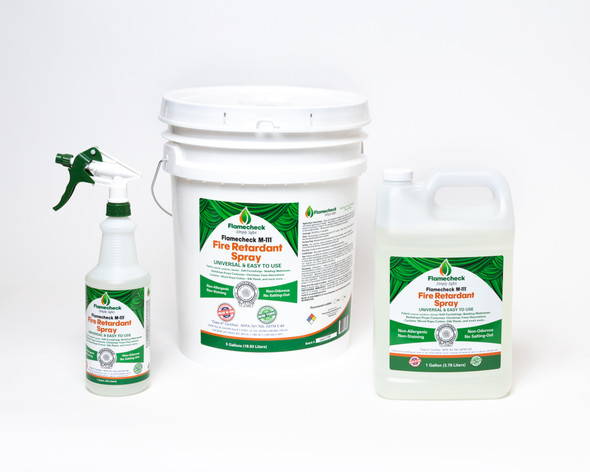Frequently bought together:
Description
BanFire meets the most common requirements looked for by US Fire Marshals, such as NFPA 701 and Life Code 101, as well as California Title 19 Section 1237.1 (CalFire Reg C-26701) for drapes, curtains and other hanging fabrics and decorations in public spaces. It is also effective on paper and cardboard. One quart treats up to 100 sq ft of fabric. BanFire is simple to apply. Just spray it on till damp, let dry, then repeat. Quart bottles comes with trigger sprayer. Thicker fabrics may require a second application on the other side. BanFire is nearly odorless. Approved for use in California and nationwide; check with your fire marshal to ensure it meets his/her requirements. Comes with documentation for the fire marshal. 
BanFire is very easy to use. Simply spray the product on the fabric and allow to air dry, then repeat. Most fabrics will require two applications. Make sure the fabric is clean, or the liquid may bring the dirt to the surface. Make sure the item gets damp. Very thick fabrics may require treating both sides of the fabric. Coverage rate is 400 sq ft per gallon.
Do not dilute. Use at 100%. You can use a simple spray bottle, a pump-up garden sprayer, or a painter's airless sprayer. For doing tall curtains, like for a theater, using a three-foot extension wand is very handy. A standard 515 airless tip works well. Be sure to flush out the airless with clean water after using.
BanFire can be applied to fabric that is laying flat, although when it dries you may notice small rings of white residue where the solution has collected in low spots. Most often, any white residue can be wiped off with a damp towel. Spraying vertical fabric should not give this result. Also, multiple light coats is better than fewer heavy coats. For velvet-like material, spray a heavier coat on the backside, and a lighter coat on the front.
You may also dip fabrics in the solution, then wring them out and allow to air dry. When dipping, the fabric may stiffen quite a bit, like when using a heavy starch. Simply work with the material, or put it in a tumble drier to 'loosen' the fabric back up.
It is always a good idea to test a small sample of the fabric for color-fastness. BanFire has been known to discolor natural jute burlap, which is quite a bit different from cotton.
Since BanFire is a water-based product, washing the treated fabric or garment will remove the retardant, so re-treatment will be necessary after washing.
BanFire has almost no discernible odor. It is often easiest to leave curtains hanging in place and treat them while still on the rod. You do not want to get the fabric so wet that it drips down in a pool at the bottom. If that happens, you may want to put down a dropcloth or towels underneath the area where you are working. If BanFire dries on a hard surface like tile or concrete, there may be a little white residue, which can be wiped up with a damp towel.
BanFire is a saturant, so it must be applied to an absorbent material. Fabrics and other materials with a high plastic content and certain polyesters will not absorb moisture, so shouldn't be used with BanFire. For sheer materials like organza, we offer a product called BanFire Poly.









